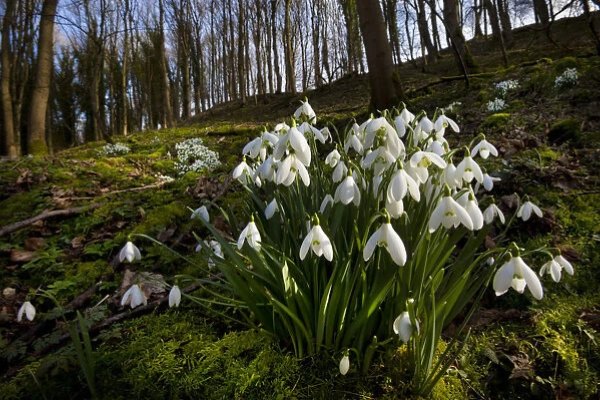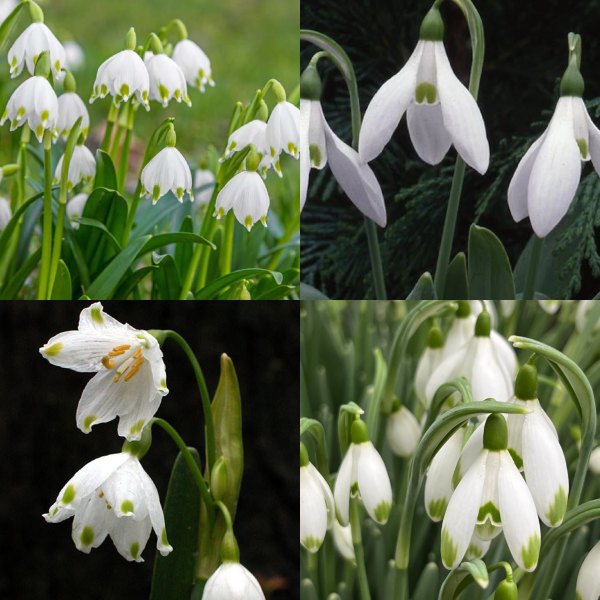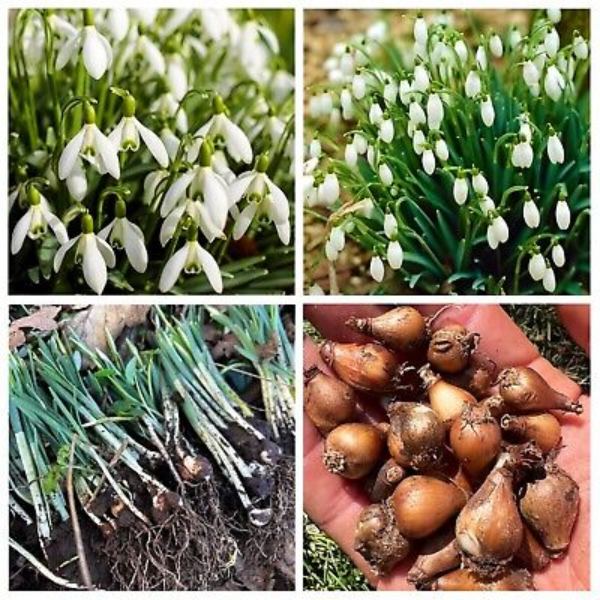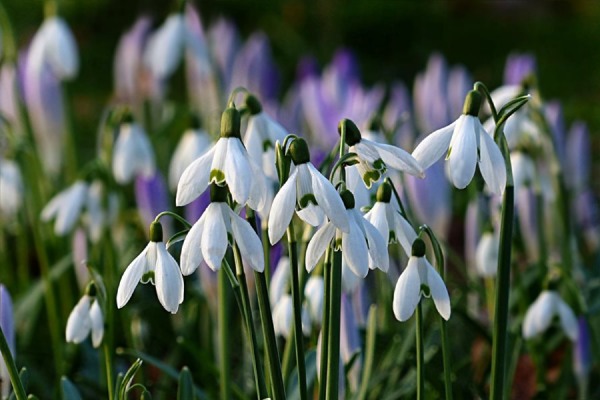Snowdrop (Galanthus nivalis) is a perennial flower renowned for being the first to bloom in spring. It stands 3 to 6 inches tall, showcasing white bell-shaped flowers and smooth, narrow, or linear leaves that are grey-green. Each flower consists of six white segments called tepals. The inner three tepals are smaller and have a distinctive notch at their tips alongside an eye-catching green, upturned ‘V’ pattern.
Snowdrops are believed to have been cultivated as ornamental garden plants since the 16th century. However, they were not recorded in the wild until the late 18th century. These flowers bloom so early in the season that they do not depend on pollinators for reproduction. Instead, they propagate through bulb division. Below, you will find additional information on Snowdrops, along with tips for their care and growth.
Plant Descriptions
Plant Type: Bulb, Perennial
Scientific Name: Galanthus spp.
Family: Amaryllidaceae
Common Name: Snowdrops, Fair Maids of February, Little Sister of the Snows, Common Bells
Genus: Galanthus
Season: Spring
Habitat: Woodland, Parks, Gardens, Grassland
Native Areas: Asia, Europe
Toxicity: Toxic to people, pets
Where do snowdrops grow best?

Snowdrops can thrive in various spots in your yard and are resilient against pests and diseases. They bloom in late winter or early spring. For optimal growth, plant snowdrops in moist but well-drained soil that doesn’t dry out in summer. Similarly, it required a partial shade location where they receive enough light in spring without being exposed to harsh summer conditions. Similarly, planting snowdrops under deciduous trees is an excellent idea, as they will naturalize and form a beautiful colony. However, snowdrops are toxic to humans, dogs, and cats. Keep kids and pets away from the plants. Despite their toxicity, snowdrops are less likely to be consumed by pests, which can be a substantial benefit.
Varieties of Snowdrop
Galanthus nivalis
Galanthus nivalis is the most commonly grown species and can often be found growing in woods and other places outside gardens. This is about 7 to 15 cm tall, with a delicate, bell-shaped white flower on a thin stem. It blooms from January to May in the wild area. These snowdrops are perennial plants and grow from bulbs. The Royal Horticultural Society has awarded the plant of Garden Merit (AGM) for its garden value.
Galanthus elwesii
Galanthus elwesii, also called ‘giant snowdrop’, is one of the largest flowering snowdrop cultivars with wide flowers of ivory white color, whose tips are green. This snowdrop grows up to twice as tall as Galanthus nivalis. It grows almost 20 to 25 cm tall and 2 to 3 cm wide. It is hardy to zone 4 and tolerates colder temperatures. The plant was first discovered in 1874 by the British botanist Henry John Elwes during his visit to Turkey. In gardens, it is grown for its ornamental beauty. When bulbs are planted in the autumn, they usually bloom in early spring.
Leucojum vernum
Leucojum vernum, commonly known as Spring Snowflake, is a popular choice for garden and park landscaping due to its ornamental appeal. This delightful flower can reach a height of 12 to 35 cm when it is fully in bloom. In early spring, it features delicate, nodding flowers that resemble white bells with green-tipped edges. Similarly, its leaves are narrow, strap-like, and rich, dark green colored. Spring Snowflake flourishes best in either full sun or partial shade and prefers moist soil conditions.
Leucojum aestivum
Leucojum aestivum, commonly known as the summer snowflake, is quite similar to Leucojum vernum. This bulbous perennial has narrow, strap-shaped leaves and bears clusters of bell-shaped flowers that are usually white but sometimes appear in pink. Each flower often has a hint of green on its tips. It blooms slightly later than other varieties, around mid-spring, and is hardy down to zone 4. The plant usually grows between 35 to 60 cm tall, as some varieties can reach up to 90 cm. It prefers well-drained soil, full sun, or partial shade. For optimal growth, allow the plant to self-seed naturally and let the foliage come back completely after flowering.

How to care for Snowdrop
Light
Snowdrops will grow well in full sun or partial shade, but they require at least 6 hours of direct sunlight daily. Since they are early spring bloomers, they typically receive sufficient light before the trees, like maples and oaks, foliate and shade them. Similarly, you can cultivate snowdrops under large deciduous trees or in places that are partially shaded and where most other plants can barely exist.
Soil
Snowdrops do well in humid, well-drained, rich soils with neutral to slightly alkaline soil pH. You can add organic matter to help the root grow in the best possible way. However, ensure the soil drains well. The bulbs can stand wetting for a short time, but excess water makes them rot
Water
Snowdrops prefer moist soil but not too wet. If it has been dry during their flowering time, water them to keep the soil slightly moist. Otherwise, it does not require excess water. The melting snow and spring rainfall usually provide adequate moisture without additional watering.
Temperature and Humidity
Snowdrops can grow in USD zones 3-9 because it doesn’t like high heat and humidity. The bulbs need temperatures below 20°F to bloom. Additionally, they can tolerate high humidity, but this is only effective if the soil has good drainage.
Fertilizer
Feed your plant with balanced nutrition fertilizers once in early spring for optimal growth of your snowdrops. Using slow-release granules or diluted liquid fertilizers can also be good options. These fertilizers help to boost vigor and improve their flowering. Always follow the instructions on the fertilizer package, and beware of putting fertilizer on the leaves which will burn them.
Pruning
Snowdrop plants generally don’t need pruning. Don’t trim their leaves or remove dead flowers. The plants use their leaves to send nutrients to the bulb until the leaves start to fade. The leaves and stems above the ground will turn brown and die off after some time as the plant goes dormant. Once the leaves and flowers drop off, the plant itself stays in the soil until the growing season arrives once again. The fallen leaves help improve the soil which supports the plant’s growth for the next blooming period.
Pest and Diseases
Snowdrops are quite hardy and pests-resistant plants. However, they can get bulb rot if they are planted in very wet or boggy soil. Another issue is a fungal disease called Snowdrop grey mold, caused by Botrytis galanthina. This disease makes a fuzzy great mold grow on the stem and leaves, especially during mild, wet winters. If you see this mold, remove and destroy the affected plants and avoid replanting in the same pot.
How to propagate snowdrops?
You can propagate snowdrops from several methods. However, the common methods include division and seedling. Growing from seeds takes longer time than dividing. To grow from seeds, you first need to collect and sow seeds as soon as they ripen. Germination should take place only when the temperatures start to rise after winter. However, most prefer to grow their snowdrop from division.

For division, wait until after the snowdrops have finished flowering in early spring. Carefully dig up a clump of bulbs with their roots. Divide the clump into smaller sections without disturbing them too much. YOu can then replant these smaller clumps at the same depth they were growing before. Water them regularly. By the next winter, your snowdrops should be healthy and growing well.
Also read, How to Grow and Care for Zinnias, a Flower That Blooms All Summer!
Frequently Asked Questions
1. Are snowdrops a spring flower?
Yes, snowdrops are a perennial flower renowned for being the first to bloom in spring.
2. Where does snowdrop grow?
Snowdrops grow in moist but well-drained soil that doesn’t dry out in summer. Similarly, it required a partial shade location where they receive enough light in spring without being exposed to harsh summer conditions.
3. Can Snowdrops be grown in pots?
Yes, snowdrops can be grown in pots. Use a pot with good drainage and plant the bulbs about 3 inches deep. Keep the pot in a cool, shaded area during their dormant period and water regularly to maintain moisture.
4. Are snowdrops deer and rabbit resistant?
Yes, snowdrops are generally deer and rabbit-resistant due to their toxicity.
5. Can snowdrops be divided?
Yes, snowdrops can be divided to propagate new plants. Wait until after the flowering period, dig up the clump of bulbs, separate them, and replant the division at the same depth.
